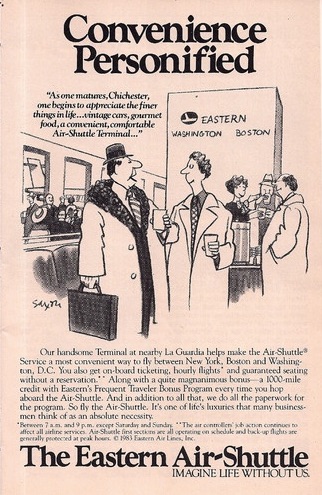I can remember the Eastern Shuttle. From the 1960s, for two decades, it departed hourly from LaGuardia to Washington D.C. and Boston. No need for reservations, no check-in, no boarding passes. Coffee cup in hand, commuters ran for the flight. If it was filled, the airline had another plane in reserve to take you to either destination. The price of the trip to D.C. was $12.75 in 1961–the equivalent of $105.54 today.
An Eastern Shuttle ad:
Now, defining cost as sacrifice, flying is much more expensive.
Airport Design
Our story starts with where we arrive–the “landside.” Parking, terminal entry, ticketing, and TSA lines compose most of the landside. Like Pittsburgh’s International Airport, most airports have too much entry space. Their past capabilities are no longer necessary. We check in on our phone apps and self-tag our baggage. We might not require as much parking and rental car capacity. What we do need is more efficiently designed screening areas.
Our real goal though is getting to the “airside” of the terminal. The airside is located past TSA lines. On the airside, we eat, we shop, we plug in…and we wait. Also on the airside, aircraft take off, they land, they refuel and handle baggage. Typically built before 9/11, the airside of airports could use resources more effectively.
Our Bottom Line: Cost
The problem is that 9/11 created an airport “flip.” The landside and the airside have traded roles. And until the architectural switch occurs, airports will cost travelers more time and aggravation.
But to make that design change, we are looking at a multi-billion dollar infrastructure cost. Summarized as food, fashion, and flow, new airport architecture will change the cost of flying by diminishing time and inconvenience. But to build new airports, WSJ tells us the price tag is $1 billion for one new terminal in Kansas City. Similarly, Pittsburgh says it will spend $1.1 billion on a rebuilding plan.
So no, the “cost” of flying will never be as “cheap” as the Eastern Shuttle. But it could be much better.
My sources and more: This WSJ airport column reminded me of a 99% invisible airport podcast. Together they provided the springboard for understanding specific airport design like San Francisco’s, I also peeked at an airline text for airside optimization. However, the best read was a NY Times “obituary” for the Eastern Shuttle.







